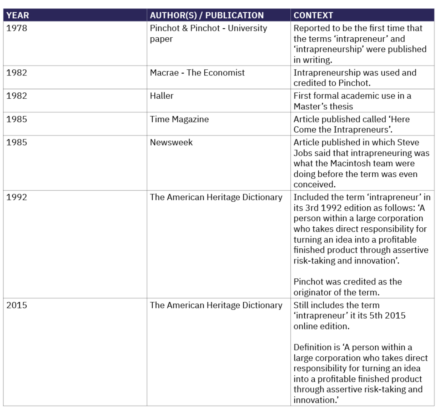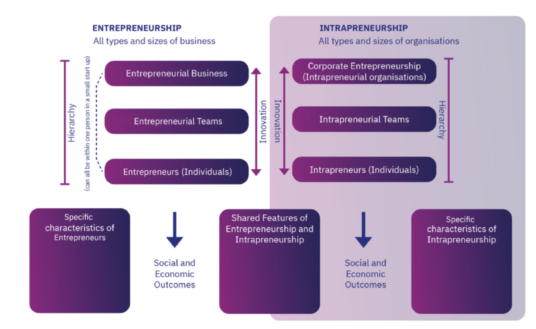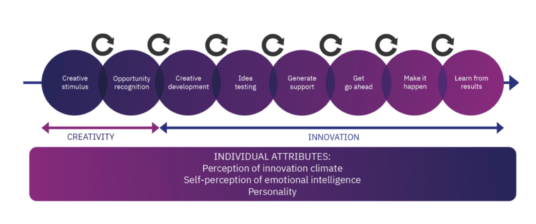Posted in Blog, Innovation, Innovation Culture, Lead, Lead Your Team by Jo North
Intrapreneurship vs entrepreneurship
I’ve always been fascinated by what makes some people really innovative and enterprising – or intrapreneurial – at work, and why some people prefer to be more risk averse and focus on managing the day-to-day, rather than actively seeking to shape the future.

I’ve also been intrigued by the motivations of people to leave the apparent “safety” of employment to become an entrepreneur.
My deep interest and curiosity has come from my own career background. Throughout my 20+ years of working in a corporate environment, I’ve always been known for spotting opportunities and speaking out about them. I wondered why some of my colleagues didn’t do the same.
Of course, my enterprising drive led me to leave that corporate world to set up my own company. I love working with my corporate clients, and of course my specialist area of expertise is business growth, entrepreneurship and innovation.
It was this sheer passion and joy for all things intrapreneurship and entrepreneurship-related that led me to study for 6 years part-time to achieve my doctorate in my late forties.
This article summarises and evaluates definitions and interpretations of intrapreneurship in order to define what the term means for people in businesses today.
It is adapted from my PhD thesis, which you learn more about here.
‘Intrapreneur’ is a relatively new word
Unlike the term ‘entrepreneur’, which has a long and rich history in the literature, being first attributed to Cantillon in the eighteenth century, the first publication of the term ‘intrapreneur’ did not occur until the late 1970s around 240 years later.
History of the term “intrapreneur”
The meaning of the term ‘entrepreneur’ has evolved over time, its starting point being in 1755 by Cantillon meaning someone who has the ability to take charge, through to today’s definitions which focus on alertness to and exploitation of opportunities in business.
In its comparatively much shorter history, the meaning of the term ‘intrapreneur’ and synonyms for ‘intrapreneurship’ have also evolved and widened.

Other terms for Intrapreneurship
Intrapreneurship has a number of synonyms.
These include:
- intrapreneuring
- corporate entrepreneurship
- internal corporate entrepreneurship
- entrepreneurial activities within an organisational setting
- corporate venturing.
Definition of Intrapreneurship and Entrepreneurship
Numerous researchers agree that intrapreneurship has its roots in entrepreneurship. Many definitions refer to intrapreneurship as being entrepreneurship within an existing organisation. Intrapreneurs are inside entrepreneurs who follow the goal of the organisation.
As intrapreneurship is closely related to entrepreneurship, it is useful to begin with a definition and understanding of entrepreneurship.
A good definition of entrepreneurship is enterprising human action in pursuit of the generation of value through the creation or expansion of economic activity, by identifying and exploiting new products, processes or markets.
Differences between Intrapreneurs and Entrepreneurs
Intrapreneurs are more like entrepreneurs than traditional managers. There are generally four key differences between entrepreneurs and intrapreneurs. These are:
1. Setting or context
Intrapreneurs operate inside an existing organisation, often needing to influence internal decision-makers.
Entrepreneurs create a new organisation and where funding or other support is required they need to influence externally.
2. Risk and resources
Intrapreneurs use employers’ resources to implement risky decisions.
Entrepreneurs either use their own resources, or sometimes also external investors’ resources to implement risky decisions.
Intrapreneurs do expose themselves to risk – reputational, and potentially career-risk at the individual level if they fail to deliver successfully – and they also take on risk on behalf of their organisation.
With innovation there is always the risk that things will not go to plan and that losses will result. Simply asking for additional resources to undertake an intrapreneurial initiative can be risky.
Intrapreneurs pursue opportunities beyond the resources already available to them and shape activities that are different from the current situation and in unpredictable, changing environments.
3. Reward
Intrapreneurs are not always rewarded financially or otherwise for their enterprising successes. Reward outcomes are contingent on terms of employment and organisational policy.
Entrepreneurs (along with their shareholders / investors) are likely to benefit directly from their endeavours, both financially and non-financially.
4. Tangible and intangible infrastructure
To a greater or lesser extent, depending on the initiative, intrapreneurs use systems, procedures, knowledge, processes and ways of working that exist within the employing organisation to get decisions made to get things done.
Entrepreneurs either need to create their own systems, procedures, knowledge, processes and ways of working, or access / borrow them from potential suppliers, partners, investors or other outside agencies.
Sources and levels of intrapreneurship
Intrapreneurship in organisations takes place at three levels:
- Organisational or company level
- Team level
- Individual level
Descriptive model of intrapreneurship
The descriptive model of intrapreneurship shownin the visual below brings tigether the diverse findings on the nature of intrapreneurship from academic and industry research.

Where does intrapreneurship happen?
Intrapreneurship tales place in the private, public, charity and government sectors. Different kinds of organisations are promoting entrepreneurial activities within their staff and management teams more and more as budgets get tighter and expectations for results get higher. Examples are the commercialisation of public sector services.
Why is intrapreneurship important?
Organisational and economic development is hugely dependent on intrapreneurship.
Intrapreneurship creates improved growth and profitability for companies and is a feature of successful organisations, including the growth of small to medium-sized enterprises (SMEs).
Intrapreneurship is essential for driving positive firm performance in competitive or challenging environments and creates competitive differentiation through new products or services.
Intrapreneurship as a trend
Entrepreneurship is much more prolific in research terms than intrapreneurship. Intrapreneurship studies have tended to surge and wane – globally as well as in specific geographies.
The intrapreneurship phenomenon appears to have started in the US, apparently driven to an extent by economic conditions, and has been picked up by other countries as they have worked to strengthen and restructure their commercial economies, for example in India, Eastern Europe and Latin America.
Which activities are included in the term ‘intrapreneurship’?
There is an underlying theme of innovation throughout the definitions of Intrapreneurship.
Intrapreneurs drive growth and renewal through introducing new products, processes, services and technologies.
Intrapreneurship is also described as the activity to start a new venture in an existing firm.
Summary definition of ‘intrapreneur’
The definition of an intrapreneur in the context of my research is as follows:
“An intrapreneur practises entrepreneurial activity in an established organisation.
He / she successfully spots opportunities that are not immediately obvious to most colleagues and makes them happen to generate positive, material results for his / her employing organisation. These results can constitute reputational, product or service development, or market development benefits to the organisation.”
The intrapreneur undertakes a range of activities towards accomplishment of the desired result, i.e. the successful exploitation of an appropriate opportunity to achieve intended positive intrapreneurial outcome for the organisation.
The Intrapreneurship Process

The Intrapreneurship Process includes a number of sub-phases, which require resilience, emotional intelligence, influence and tenacity:
- Creative stimulus stage – in which the intrapreneur is absorbing information, connections and inspiration as the source of the potential new intrapreneurial idea or concept.
- Opportunity recognition – in which the intrapreneur experiences a cognitive process to identify what the new idea is and how the new idea could be exploited or realised.
- Creative development – in which the intrapreneur develops the new concept further to make it more robust or add greater intrinsic value.
- Idea testing – in which the intrapreneur undertakes some research or takes soundings to test the potential for the new concept to succeed.
- Generate support – influencing to mobilise active support from enabling individuals or organisations to access resources, funding, political endorsement. The intrapreneur needs to be able to motivate people internally across functions to support the implementation and delivery of his / her initiative and also lead a diverse team of people. This stage also includes influencing and providing reassurance of success and results.
- Get the go ahead – generating the final permission to proceed with launching the new intrapreneurial concept.
- Make it happen – delivering the launch and live application of the new concept.
- Learn from the results – reflective practice to identify how to strengthen the outcomes from the project to develop and launch the new concept; lessons identified that can also be applied to future projects.
This Intrapreneurship Process is not likely to be completely linear when it takes place in reality. It is much more likely that the intrapreneur will cycle forwards and backwards between stages as new information, challenges or opportunities emerge.
You can read more detail about the Intrapreneurship Process in my article here.
Intrapreneurial judgement
In addition, if a potential intrapreneurial initiative appears likely to lack the generation of organisational traction as activities develop, the intrapreneur may choose to abandon or postpone pursuit of the initiative at any stage. This may be to replace such initiatives with ones that have greater potential, to protect the intrapreneur’s credibility, or to simply await better timing, along with other potential reasons to pause or postpone.
The successful intrapreneur will use their judgement in determining which ideas should be fully pursued and which should be left. The intrapreneur is unlikely to pursue all the creative ideas for growth that they generate using a self-imposed and potentially intuitive rather than deliberative personal ‘innovation funnel’ or ‘filter’ that is analogous to organisational processes, if not as deliberate.
Selecting the most appropriate new intrapreneurial initiatives to progress and identifying which ones should be rejected is likely to comprise a critical success factor for the intrapreneur.
Intrapreneurial attributes
In order to action this process, the intrapreneur needs to possess self-efficacy, a form of strong inner belief in their ability, and intrapreneurial motivation, supported by a positive perception of the innovation culture within their organisation.
Having selected an idea that has potential for the organisation, the successful intrapreneur is likely to undertake a series of activities that require different attributes in order for the process to be negotiated successfully, to bring new ideas through to implementation.
It is unlikely that all employees are intrapreneurial. It is also likely that some employees are more inclined towards intrapreneurial endeavours than others.
The successful intrapreneur
My research, which you can read in detail here, indicates that the successful intrapreneur is an individual who is highly driven when it comes to pushing boundaries to make things happen, who gets energy from external sources and who does enough to get along with others and play closely enough to the organisation’s rules.
The successful intrapreneur is open to new thinking but also has a clear vision of their own for what should be done and how to achieve success.
The intrapreneur is also aware of the risks that are inherent to driving innovation, which makes them vigilant, focused and assertive to avoid failure and optimise the chances of success for their project.
The successful intrapreneur keeps their eye on the ball and drives their initiatives through, is not too concerned about getting along with everybody involved in the process, does not pay too much attention to rules and structure, but will work within them as necessary, and has a reasonably open view about what they want to happen and how.
Also, the successful intrapreneur is a positive, optimistic and sociable person (which probably means they are forgiven for being only somewhat concerned with agreeableness and conscientiousness at times!).
To achieve successful intrapreneurial outcomes for the employing organisation, the individual intrapreneur needs that organisation to be willing and able to change, interested in new idea generation, open to taking risks on new initiatives and providing support for its intrapreneurs’ ideas. Anything less is likely to create an obstacle that would not only impede intrapreneurial progress but also potentially frustrate intrapreneurial employees.
Great books on Intrapreneurship and Entrepreneurship
Some great books on the themes of intrapreneurship and entrepreneurship are:
Exploring Entrepreneurship by Richard Blundell and Nigel Lockett
A classic, Change Masters by Rosabeth Moss Kanter
And my own book! Idea Time by Dr. Jo North
Next steps
If you’d like to know more about how to build intrapreneur development and intrapreneurship skills and capability in your organisation, please get in touch for a no-obligation, free consultancy call using the contact us form below.
We use a combination of hands-on consulting, innovation-focused executive development, innovation sprints, design sprints and excellent event design and facilitation to help our clients accomplish exceptional results.
Everything we offer is tailored to meet the specific needs of our individual clients. From the outset we build a very clear picture of our clients’ goals and aspirations, then guide and facilitate a detailed examination of their current position, identifying areas of strength, weakness and opportunity. This is used as a foundation for devising a tailored strategy using cutting-edge techniques and proven business acumen to establish where we can best assist each client.
Our aim is not simply to provide short-term solutions (although we are very good at that too), but to give our clients the tools to achieve deep and sustainable success.
We pride ourselves on the standard of service we offer and the results we help our clients achieve.
We’d love to hear from you, so please do get in touch!

